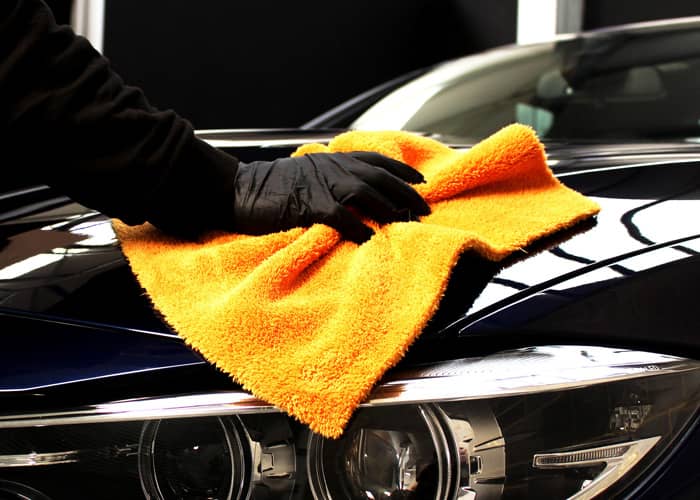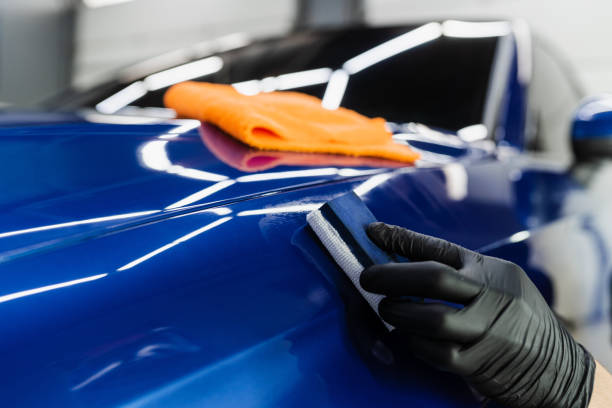How Outlining Ceramic Layer Improves the Longevity of Your Car's Paint
Ceramic finishing has arised as a crucial technology in automobile outlining, providing a durable option for protecting the honesty of your auto's paint. Recognizing the intricacies of just how ceramic layer works and its advantages over standard wax can give valuable insights for cars and truck owners.
What Is Ceramic Layer?
Understanding the safety advantages of ceramic coating starts with acknowledging its structure and performance. Ceramic coating is a liquid polymer related to the outside surfaces of cars, mostly made to boost and safeguard automobile paint. The vital component of this covering is silicon dioxide (SiO2), which is obtained from all-natural products like sand. This compound forms a strong chemical bond with the factory paint, developing a protective layer that is both long lasting and hydrophobic.
The finishing's application entails meticulous prep work of the lorry's surface area, which must be devoid of pollutants, scratches, and imperfections to guarantee optimal attachment. As soon as applied, the ceramic covering cures to develop a stiff shield that can endure different ecological aspects, including UV rays, chemical spots, and oxidation.
Additionally, ceramic coatings are not merely surface-level treatments; they penetrate the paint to give a lasting protection. This performance prolongs the life expectancy of the automobile's visual appeals while keeping its value over time. Understanding these fundamental elements of ceramic finish is vital for car owners looking for efficient solutions for paint preservation and improvement.
Benefits of Ceramic Finishing
The benefits of ceramic finish extend far past its fundamental safety attributes - Conforti Auto and Marine Detailing Ceramic Coating. One of the most substantial advantages is its capacity to offer extraordinary resilience. Unlike traditional wax or sealers, ceramic finishes produce a strong bond with the car's paint, enabling it to stand up to ecological dangers such as UV rays, acid rain, and road salt. This resilience considerably lowers the risk of paint damage, preserving the automobile's visual charm.
Additionally, ceramic finishes provide hydrophobic buildings, suggesting they drive away water and contaminants. This particular not just makes the lorry easier to tidy however likewise lessens the regularity of washing, conserving both effort and time for automobile owners. The slick surface area created by the coating avoids dirt and crud from adhering, enhancing the automobile's total tidiness.
Moreover, ceramic finishings enhance the deepness and quality of the paint, giving vehicles a shiny finish that is visually striking. This visual improvement better adds to preserving the vehicle's resale value, as a well-maintained outside is a major marketing factor for prospective buyers. On the whole, the advantages of ceramic finish make it a rewarding financial investment for any individual looking to secure and improve their automobile's paintwork.
Just How Ceramic Layer Functions

The coating's hydrophobic properties ward off water and dirt, avoiding the buildup of crud externally. This not just makes the automobile simpler to clean but also reduces the possibility of scrapes and swirl marks triggered by conventional washing techniques. The ceramic layer acts as a guard against UV rays, which can trigger fading and oxidation over time.
As soon as cured, the finish exhibits exceptional resistance to chemicals, consisting of road salts, bird droppings, and tree sap, which these details can or else damage the paint. The longevity of ceramic finishings can last for numerous years, depending on aspects such as upkeep and environmental problems. On the whole, the chemical bonding process of ceramic finishings gives a robust protection that keeps the integrity and appearance of an automobile's paintwork.
Contrasting Ceramic Finishing to Wax
Contrasting ceramic covering to standard wax exposes substantial distinctions in performance and longevity. While both products intend to secure an automobile's paint, their compositions and toughness established them apart. Wax, normally made from all-natural carnauba or artificial products, offers a temporary shield that normally lasts just a few weeks to a few months, relying on environmental problems and maintenance regimens.
In contrast, ceramic coatings are sophisticated remedies composed of not natural materials that bond chemically with the car's paint. This produces a robust, semi-permanent layer of protection that can endure for a number of years. As a result, ceramic layers supply exceptional resistance to UV rays, chemical discolorations, and physical abrasion, significantly reducing the risk of oxidation and fading.
In addition, the hydrophobic homes of ceramic finishes guarantee that water grains up and rolls off the surface, find more making it a lot more challenging for dust and gunk to stick. This ease of cleaning is a significant benefit over wax, which can bring in dust and need frequent reapplication. Eventually, for cars and truck owners seeking lasting defense and enhanced visual allure, ceramic coverings provide a much more effective option to conventional wax products.
Upkeep Tips for Long Life
Appropriate upkeep is vital for making best use of the durability of a ceramic coating. Utilize a pH-balanced automobile shampoo to stop weakening the covering, and stay clear of automated car cleans with extreme brushes that can create micro-scratches.
To maintain the hydrophobic homes of the ceramic coating, consider applying an upkeep spray or booster particularly designed for ceramic finishings every couple of months. This will certainly strengthen the protective layer and boost water beading.
Furthermore, avoid revealing the coated surface area to severe environmental conditions whenever feasible. Auto parking in shaded areas or making use of a car cover can protect against UV damages and contamination from bird droppings, tree sap, or commercial results.
Last but not least, evaluate the layer periodically for indications of wear or damage. If you notice a decline in hydrophobic actions, it might be time for a professional reapplication. By adhering to these maintenance pointers, automobile owners can significantly expand the life and effectiveness of their ceramic coating, making sure that their automobile's paint visit stays safeguarded and aesthetically appealing for many years to come.
Final Thought
